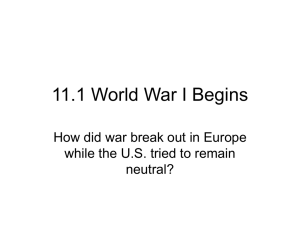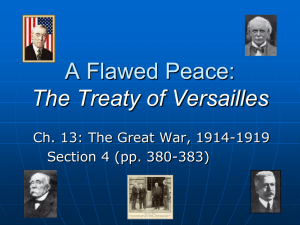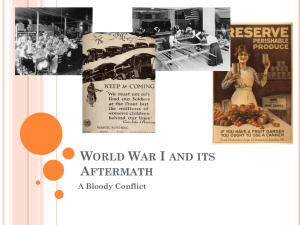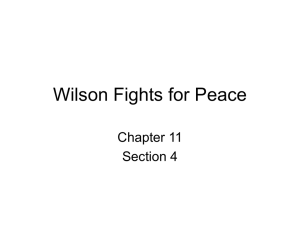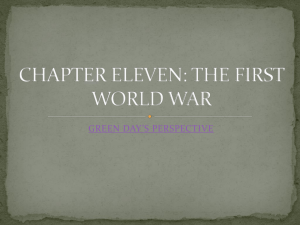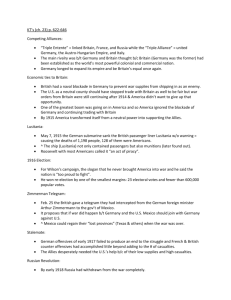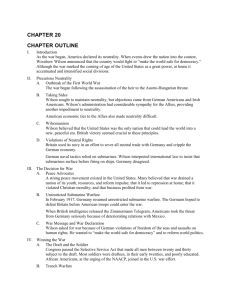Chapter 24 Notes - Mahopac Central School District
advertisement
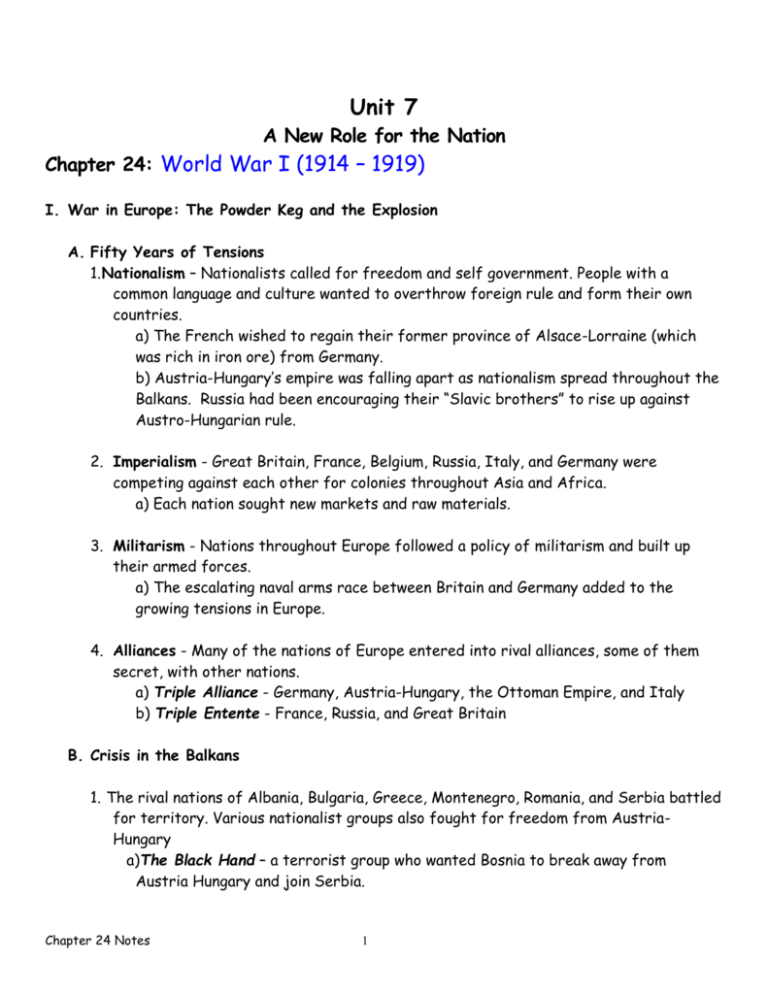
Unit 7 A New Role for the Nation Chapter 24: World War I (1914 – 1919) I. War in Europe: The Powder Keg and the Explosion A. Fifty Years of Tensions 1. Nationalism – Nationalists called for freedom and self government. People with a common language and culture wanted to overthrow foreign rule and form their own countries. a) The French wished to regain their former province of Alsace-Lorraine (which was rich in iron ore) from Germany. b) Austria-Hungary’s empire was falling apart as nationalism spread throughout the Balkans. Russia had been encouraging their “Slavic brothers” to rise up against Austro-Hungarian rule. 2. Imperialism - Great Britain, France, Belgium, Russia, Italy, and Germany were competing against each other for colonies throughout Asia and Africa. a) Each nation sought new markets and raw materials. 3. Militarism - Nations throughout Europe followed a policy of militarism and built up their armed forces. a) The escalating naval arms race between Britain and Germany added to the growing tensions in Europe. 4. Alliances - Many of the nations of Europe entered into rival alliances, some of them secret, with other nations. a) Triple Alliance - Germany, Austria-Hungary, the Ottoman Empire, and Italy b) Triple Entente - France, Russia, and Great Britain B. Crisis in the Balkans 1. The rival nations of Albania, Bulgaria, Greece, Montenegro, Romania, and Serbia battled for territory. Various nationalist groups also fought for freedom from AustriaHungary a)The Black Hand – a terrorist group who wanted Bosnia to break away from Austria Hungary and join Serbia. Chapter 24 Notes 1 2. Fatal Shots - In late June of 1914, a Serbian terrorist group called the Black Hand assassinated the Archduke Francis Ferdinand of Austria-Hungary and his wife as they visited the city of Sarajevo. 3. Alliances lead to war - The alliance systems quickly turned a regional confrontation into a continental crisis. a) Austria-Hungary (T. All.) demanded Serbia surrender members of the Black Hand to them and Serbia refused to do so. b) Russia (T. Ent.) promised to defend Serbia against any possible attack. Germany (T. All.) promised to defend Austria-Hungary from any attack by Russia. c) Austria-Hungary mobilized its troops in July and Russia followed suit. When Russia mobilized its forces Germany mobilized its troops in response. When Germany readied its military, France (T. Ent.) mobilized its military forces to counter any possible threat to itself and Russia. 3. The war started on August 1st when Germany declared war on Russia. On August 3rd, Germany declared war on France and on August 4th, Britain (T. Ent.) entered the war when Germany marched through neutral Belgium in order to attack France. C. The Course of the War: 1914 - 1917 1. The people of Europe readily supported their nations’ war efforts and many believed the war would last only a couple of months and that the troops would be home by Christmas. a) Central Powers – Germany, Austria Hungary, and the Ottoman Empire (Turkey). b) Allied Powers – France, Britain, and Russia. 2. The war quickly became bogged down on the Western Front (France/Germany) and on the Eastern Front (Germany/Russia) by late 1914. 3. Trench Warfare - Both sides dug defensive trenches and used weapons such as machine guns, barbed wire, flamethrowers, and heavy artillery to defend them. Between the frontline trenches of each side lay “no man’s land.” a) Verdun cost the French and Germans nearly one million men over the course of 10 months in 1916. b) On July 1, 1916, the British lost over 19,000 men during the first day of the Battle of the Somme. The battle would continue for several months. c) Stalemate – neither side was strong enough to defeat the other. d) Devastating new weapons such as airplanes, chemical gas, and tanks were also used on the battlefield. Chapter 24 Notes 2 4. Losses on the Eastern Front – Stalemate and trench warfare occurred on the eastern front as well. By mid 1916, the Russians had lost over 1,000,000 soldiers. D. American Neutrality – In 1914, Americans were determined to avoid being drawn in a European War. 1. Divided Opinion - On August 19, 1914 President Wilson officially declared the United States neutral. Millions of Americans had close ties to the nations at war on both sides. a) Many Americans favored the Allies. The U.S. had long standing ties to Britain and France had been our Ally in the American Revolution. b) On the other hand, about 8 million Americans were of German or Austrian descent. Also, many Jewish Americans had fled persecution (pogroms) in Russia. 2. Impact of the War - The war caused our economy to boom. a) Both the Allied and Central Powers needed food, weapons, oil, steel, and other goods. b) By 1917, trade with the Allies was much greater than trade with the Central Powers. 3. Both sides conducted a propaganda war in the United States. a) Propaganda – the spreading of ideas or beliefs that help a particular cause and hurt an opposing cause. Each side pictured the other as savage beasts who killed innocent civilians. E. Freedom of the Seas 1. America’s declared neutrality did not prevent its ships from being attacked. a) Early in the war, Britain began a naval blockade of Germany and Germany responded with a naval blockade of Britain using its U-boat fleet (undersea boats). b) Germany began a policy of unrestricted submarine warfare around the British Isles. In 1915, a German submarine torpedoed and sank the RMS Lusitania, a British passenger ship, off of the coast of Ireland. Nearly 1,200 people died, including over 100 Americans. c) President Wilson threatened to break off official diplomatic ties with Germany if Germany did not stop attacking passenger ships on the high seas. d) In order to prevent the U.S. from entering the war on the side of the Allies, the Germans agreed to the Sussex Pledge; Germany promised that in the future all Uboats would surface and give warning before attacking any ship. Chapter 24 Notes 3 II. “Safe for Democracy” A. Wilson the Peacemaker? 1. Early in August of 1914, Wilson called for a quick and peaceful end to the war and he offered to mediate peace negotiations. 2. Wilson Campaigned for and won re-election on the central platform that “He kept the U.S. out war.” B. The Shift towards War 1. Renewal of Submarine Warfare - In a desperate attempt to end the allied blockade, Germany announced it would renew its use of unrestricted submarine warfare on February 1, 1917. a) Wilson ordered the U.S. to cut all official diplomatic ties with Germany. b) Germany gambled that they could defeat the Allies before the American troops could reach Europe. 2. Zimmerman Telegram a) German Foreign Secretary Zimmerman wanted Mexico to attack the U.S. in return for the American Southwest and financial considerations. b) The American public was infuriated when they were informed of the alleged German proposal to Mexico. 3. Revolution in Russia - as conditions at home and on the battlefront worsened, discontent grew. a) A shortage of food resulted in riots. A new revolutionary democratic government was established and it vowed to continue fighting the war. b) The fall of the government of Russia that was headed by Czar Nicholas II made it easier for Wilson to support the Allies. 4. On April 2, 1917, Wilson went to Congress and requested a Declaration of War against Germany. On April 6th Congress voted 455 to 56 to approve the President’s request. Chapter 24 Notes 4 C. Calling Up the Troops 1. By mid 1917, Great Britain and France were on the brink of collapse and Russia was on the verge of a civil war. 2. In order to increase the size of the military Congress passed the Selective Service Act - all men between the ages of 21 to 30 for the draft. a) In the next 18 months, 4 million men and women joined the armed forces. b) While men drilled for combat, women served as radio operators, clerks, and stenographers. c) By the end of the war the military had over 4 million members including Puerto Ricans, Filipinos, new immigrants, Native Americans, and nearly half a million African Americans. D. Managing the War Effort 1. A number of new agencies and departments were established to manage the war effort. a) The Food Administration, headed by Herbert Hoover, was established to ensure adequate food production for the war effort. b) Farmers grew more crops and families planted “victory gardens.” “Food will win the war.” c) The War Industries Board coordinated the production of war materials. d) The War Labor Board was established to prevent strikes by settling labor disputes. e) The Committee on Public Information was set up to help create and maintain a unified war effort. 2. Propaganda Posters - Americans were encouraged to do everything from conserving food to buying Liberty Bonds. Movie stars helped sell Liberty Bonds. a) By buying bonds, American citizens were lending money to the government to pay for the war. Bonds raised $21 million. 2. Women at Work – As men joined the armed forces women stepped in to do their jobs. a) assembled plane and weapons parts. b) Drove trolley cars, became police officers, and delivered mail. E. Tensions and Protests 1. Violence Against African Americans - Nearly half of a million African Americans moved to northern cities to fill factory jobs and other key positions. Chapter 24 Notes 5 a) Competition for housing and jobs led to race riots. b) In 1917, 39 African Americans were killed during a race riot in East St. Louis, Illinois. 2. Immigrants From Mexico – In the Southwest, ranchers pressed the government to let more Mexicans cross the border. a) 100,000 Mexicans entered the U.S. to work on farms. b) Some moved to cities to work in factories. c) After the war the U.S. tried to force them to return to Mexico. 3. Attacks on German Americans - Anti-German prejudice was evident throughout the country. a) German composed music was no longer played in public, the German language was no longer taught in schools, people of German heritage were terrorized and threatened, and their loyalty was called into question. 4. Opposition to War - Not all Americans supported the war for a variety of reasons. a) Many citizens began to speak out publicly against the war. b) Pacifists – people who refuse to fight in any war because they believe all war is evil. c) Congress passed the Espionage Act of 1917 and the Sedition Act of 1918 to discourage any public criticism of the war. d) Eugene V. Debs, a prominent Socialist leader, and nearly 1,900 others were tried under these laws (Debs was sentenced to 10 years in prison in 1918 for violating the Espionage Act). e) In 1919, The U.S. Supreme Court ruled on the Schenck v. U.S. - The Court ruled that freedom of speech can be limited when there is a “clear and present danger.” Chapter 24 Notes 6 III. “Over There” A. Hard Times for the Allies 1. In late 1917 and early 1918, the Allies were in desperate straights. a) The Allies were beginning to wear down from continued German pressure. 2. In November of 1917, the October Revolution took place and a communist government, headed by Vladimir Lenin, overthrew the revolutionary democratic government. a) In March of 1917, Russia and Germany signed the Treaty of Brest-Litovsk, which brought an end to Russia’s involvement in the war. b) Germany was able to shift its forces from the Eastern Front to the Western Front. 3. In early 1918, Germany launched its “Peace Offensive” against the Allies in France. a) The Germans were only about 40 miles from Paris when they were finally stopped. b) Part of the force that was able to stop the German advance was composed of “green” American troops. B. Americans in France 1. By early 1918, American troops (“doughboys”) began to arrive in France in large numbers. 2. The American Expeditionary Force (AEF) was headed by General John “Blackjack” Pershing. a) Except for a small number placed under French and British command, most US forces stayed under American command. 3. The Harlem Hell Fighters – the 369th United States infantry, an all black unit, were among the first to be attached to the French army. a) They spent more time under fire than any other American Unit. b) After the war they were recognized with numerous awards and a huge parade in New York City. C. Final Battles 3. In June of 1918 US forces entered the war in large numbers. a) At the Battle of Belleau Wood U.S. Marines drove back German forces for nearly three weeks and suffered thousands of casualties in the process. Chapter 24 Notes 7 b) In late September of 1918, nearly 1.2 million American soldiers took part in a major Allied offensive. After nearly 50 days, the Battle of the Argonne Forest came to an end. The U.S. suffered approximately 120,000 casualties (10% casualty rate). 2. The German military was facing defeat in early November of 1918 and it was only a matter of time before they would be overwhelmed by the Allies. a) Germany could no longer replace many of its troop loses and the British blockade was causing a massive food shortage on the eve of winter. D. Peace At Last 1. President Wilson sent two conditions for an armistice: Germany must accept his plan for peace, and the German emperor must give up power. a) On November 9th, Kaiser Wilhelm II abdicated the throne and a new government was established. b) At 11 AM on November 11th the deadliest war the world had ever seen came to an end. c) armistice- an agreement to stop fighting. 2. The Costs of War - Europe was in shambles at the end of the war and the people and governments of many European nations faced a number of major problems. a) An entire generation of young men (nearly 9 million) lay dead. b) An estimated 10 million civilians were killed and millions of children were orphaned. c) Millions of people were homeless because many cities, towns, and villages had been complete destroyed and many of the soldiers returning home had no employment. d) There was a shortage of essential supplies including food and medicine and disease was spreading throughout Europe. A deadly strain of the flu spread around the world killing 500,000 Americans and more than 30 million people world wide. Chapter 24 Notes 8 IV. The Failed Peace A. Wilson’s Plan for Peace 1. Wilson arrived in France determined to achieve a just and lasting peace. However, many Allied nation wanted to punish Germany. 2. In January of 1918, Wilson presented his peace plan, called The Fourteen Points, which was designed to prevent future wars. 1) No secret agreements or alliances 2) Freedom of the seas 3) Free trade (elimination of all international tariffs) 4) Limits on Armaments 5) Peaceful adjustments to all colonial claims 6) - 13) Involved making territorial settlements in Europe “along clearly recognizable lines of nationality.” Self-determination – national groups had the right to their own territory and forms of government. 14) Establishment of an “association of nations (League of Nations).” Its job would be to protect the independence of all countries, large and small. 3. In November of 1918, Germany agreed to an Armistice based on the understanding that The Fourteen Points would be the basis of any peace treaty/agreement. 4. Weaknesses of the Plan – Some goals were too vague, and others conflicted with reality. Wilson faced a constant battle. B. The Paris Peace Conference 1. Representatives from 30 different nations met in Paris and Versailles to negotiate five separate treaties which became known as the Peace of Paris. a) The four lead Allied delegates were known as the “Big Four.” 1. Premier V. Orlando of Italy 2. Prime Minister D. L. George of Great Britain 3. President Woodrow Wilson of the United States 4. Premier G. Clemenceau of France 2. Each of the “Big Four” had their own overall goals and many of their key ones conflicted with those who were at the negotiation table. a) France and Britain wanted to cripple Germany so it would no longer be a threat to them. Chapter 24 Notes 9 They insisted that Germany pay reparations, or payments, for their losses during the war They demanded that Germany take full responsibility for the war (war guilt). They stipulated that Germany drastically limit its armed forces. b) Wilson called for “peace without victory” and opposed anything more than a moderate punishment of any nation. c) In the end, Wilson had to agree to some of the demands of the French and British in order to preserve some of his key Fourteen Points (especially the League of Nations) in the final peace treaty. 3. The Treaty of Paris - The finalized treaty of June of 1919 was devastating to Germany. a) German had to pay over $300 billion in reparations to the Allies (excluding the United States) for damages created by the war. b) The German Army was limited to no more than 100,000 soldiers, the German Navy was severely limited, and Germany was not allowed to possess any military aircraft. c) Alsace-Lorraine was returned to France. d) Germany’s oversees colonies were divided among Great Britain and France by the newly formed League of Nations. e) Parts of Germany were occupied by British and French Troops to ensure Germany paid war reparations. f) Germany had to take full responsibility for the war (Article 231). 4. None of the parties involved were fully satisfied by the treaty. a ) Germany was forced, by the Allies, to sign the treaty. b) Wilson did gain a few of his key Fourteen Points besides the League of Nations. c) The principle of self-determination was implemented in a limited way in Eastern Europe. Poland was created out of German and Russian territory. Austria-Hungary was divided into a number of separate nations including Austria, Hungary, Czechoslovakia (some of its territory was taken from Germany), and Yugoslavia. Chapter 24 Notes 10 C. The Senate and the Treaty 1. Upon his return to the United States in 1919, Wilson faced an uphill battle to get the treaty ratified by the United States Senate. The main criticism of the treaty was that it would require the United States to join the League of Nations. a) Members of Congress, led by Senator Henry Cabot Lodge, feared that Article 10 of the treaty would require the United States to get involved with international disputes that it was not a direct party of. b) President Wilson refused to modify any part of the treaty including Article 10. 2. After touring the nation to gain support for the ratification of the treaty, Wilson suffered a stroke after returning to the White House. a) Wilson was unable to negotiate with Congress anymore because the White House hid the fact he suffered a stroke from Congress and the American people. 3. In November of 1919, the Senate rejected the Treaty of Versailles and the United States did not join Wilson’s prized League of Nations. Chapter 24 Notes 11
